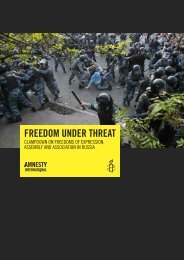From McLibel to e-Libel (correction) - Recurring problems in Defamation Law
From McLibel to e-Libel (correction) - Recurring problems in Defamation Law
From McLibel to e-Libel (correction) - Recurring problems in Defamation Law
Create successful ePaper yourself
Turn your PDF publications into a flip-book with our unique Google optimized e-Paper software.
Social media and onl<strong>in</strong>e publication not only require reconsideration of almost<br />
every aspect of defamation law from publication <strong>to</strong> defences <strong>to</strong> quantum of<br />
damages, but appear <strong>to</strong> be contribut<strong>in</strong>g <strong>to</strong> the rise <strong>in</strong> the number of litigants <strong>in</strong><br />
person, as most persons su<strong>in</strong>g and be<strong>in</strong>g sued are ord<strong>in</strong>ary members of the<br />
community.<br />
Litigants <strong>in</strong> person: The high proportion of litigants <strong>in</strong> person <strong>in</strong> defamation (around<br />
25% of all pla<strong>in</strong>tiffs and 20% of all defendants at trial level 5 ) has impacted on court<br />
case management, particularly <strong>in</strong> social media/email claims where the litigant <strong>in</strong><br />
person is a defendant. What are the causes – the <strong>in</strong>creas<strong>in</strong>g “do it yourself”<br />
approach engendered by consult<strong>in</strong>g Internet “experts” (or Wikipedia), lack of<br />
<strong>in</strong>surance, high legal costs or all of the above?<br />
Onl<strong>in</strong>e and ISP defendants: It seems <strong>to</strong> be generally agreed by courts that the<br />
liability of Internet search eng<strong>in</strong>es, social media platforms and onl<strong>in</strong>e discussion<br />
forums is not settled: Rana v Google Australia Pty Ltd [2013] FCA 60 at [50] and<br />
Marshall v Smith [2013] WASC 451 at [50]. The situation has not become any<br />
clearer over the past twelve months.<br />
Defences: The uniform legislation 6 , drafted at a time when even the Internet’s<br />
possibilities were only beg<strong>in</strong>n<strong>in</strong>g <strong>to</strong> be unders<strong>to</strong>od 7 , is struggl<strong>in</strong>g <strong>to</strong> ma<strong>in</strong>ta<strong>in</strong> the<br />
necessary tension between freedom of speech and protection of reputation. Both the<br />
Section 26 (cut down by the Court of Appeal <strong>in</strong> Besser v Kermode (2011) 282 ALR<br />
314) and “Hore-Lacy” (David Syme & Co v Hore-Lacy [2000] 1 VR 667) defences<br />
(snipped out of New South Wales <strong>in</strong> Bateman v Fairfax Media Publications Pty Ltd<br />
(No 2) [2014] NSWSC 1380 – cf Setka v Abbott [2014] VSCA 287) have been the<br />
subject of contradic<strong>to</strong>ry judicial <strong>in</strong>terpretations.<br />
Damages: 2014 was a year for big awards, but analysis of judicial approaches <strong>to</strong><br />
damages (compar<strong>in</strong>g Cerutti v Crestside Pty Ltd [2014] QCA 33 and Fisher v<br />
Channel Seven Sydney Pty Ltd (No 4) [2014] NSWSC 1616) demonstrates some<br />
widely differ<strong>in</strong>g views as <strong>to</strong> how damages should be assessed.<br />
Costs issues: It did not get any cheaper <strong>to</strong> run defamation trials. Estimates for trials<br />
ranged from a mere $100,000 for a 3-day trial brought by a homeless person su<strong>in</strong>g a<br />
a6d03e73732a/Presentation/PublicationAttachment/d883b0ed-1f24-4ed6-ad3dbb5bef5006e4/Global%20<strong>Defamation</strong>%20and%20social%20media.pdf.<br />
5 See the relevant extracts from Tob<strong>in</strong> & Sex<strong>to</strong>n, Australian <strong>Defamation</strong> <strong>Law</strong> and Practice, LexisNexis (“Tob<strong>in</strong><br />
& Sex<strong>to</strong>n”) set out <strong>in</strong> the section on litigants <strong>in</strong> person, below.<br />
6 See <strong>Defamation</strong> Act 2005 (NSW); <strong>Defamation</strong> Act 2005 (Qld); <strong>Defamation</strong> Act 2005 (SA); <strong>Defamation</strong><br />
Act 2005 (Tas); <strong>Defamation</strong> Act 2005 (Vic); <strong>Defamation</strong> Act 2005 (WA); Civil <strong>Law</strong> (Wrongs)<br />
Amendment Act 2006 (ACT) (amend<strong>in</strong>g the Civil <strong>Law</strong> (Wrongs) Act 2002 (ACT)); <strong>Defamation</strong> Act 2006<br />
(NT) (collectively referred <strong>to</strong> as the ‘uniform legislation’). The State Acts commenced on 1 January<br />
2006 and the Terri<strong>to</strong>ry Acts <strong>in</strong> 2006 (ACT: 23 February; NT: 26 April).<br />
7 In Dow-Jones and Company v Gutnick [2002] HCA 56; (2002) 210 CLR 575 at [75] – [92], Gleeson CJ,<br />
McHugh, Gummow and Hayne JJ (at [38]) described the Internet as merely “a considerable technological<br />
advance” <strong>in</strong> terms of mass communication, add<strong>in</strong>g that they were satisfied that radio and television created “the<br />
same k<strong>in</strong>d of problem” (at [38]). Concerns about terri<strong>to</strong>rial issues aris<strong>in</strong>g from the Internet’s lack of<br />
geographical presence were “irrelevant” because of Australian choice of law rules (at [42]); s<strong>in</strong>ce defamation<br />
should be “located at the place where the damage <strong>to</strong> reputation occurs” (at [44]), those issues could be readily<br />
resolved.<br />
2



